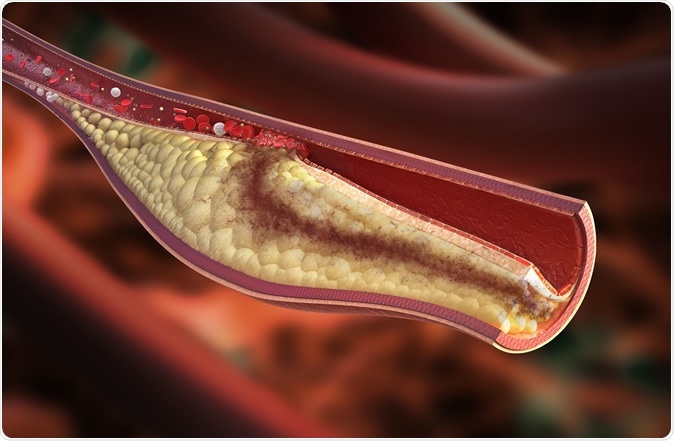Researchers from Michigan State University and Stanford University have designed special nanoparticles which could break down an atherosclerotic plaque from within. This could prevent heart attacks say researchers. The study titled, “Pro-efferocytic nanoparticles are specifically taken up by lesional macrophages and prevent atherosclerosis,” was published in the latest issue of the journal Nature Nanotechnology.
The team led by Bryan Smith, associate professor of biomedical engineering at MSU, have called these special nano particles as a “Trojan horse” that could reach the atherosclerotic plaques that block the arteries of the heart and break it from within while eating away the debris created from the breakdown.

Atherosclerotic plaque development. Image Credit: Rocos / Shutterstock
The team designed these nano particles that could specifically target the atherosclerotic plaques clogging up the heart arteries. The nano particles are microscopic carbon tubules, the team explained. These tubules contain a special drug called the SHP1 inhibitor.
These plaques normally are made up of platelets and cholesterol deposits and are teeming with immune cells. These nano particles are taught to target monocytes and macrophages, which are immune cells commonly found in the plaques. These smart particles then reach within the plaques and take with them the drug agent SPH1 inhibitor. This agent then stimulates the immune cells so that they break down and engulf the broken pieces of the plaques. Thus, the arteries are cleared of the plaques with the nanocarriers carrying in the plaque busting drugs. The plaque size could be reduced remarkably say the researchers and this could reduce the risk of heart attacks that is one of the leading killers around the world.
Within the macrophases inside the plaques, there is a signalling pathway called the SHP1 pathway/ This pathway normally prevents the cells from eating up dead cells or debris or apoptosis. These debris are created within the cores of the plaques, wrote the researchers. If the signalling pathway is blocked, the macrophages go on a killing and engulfing spree and thus clear the debris left by the broken plaques.
A typical feature of an atherosclerotic plaque, wrote the researchers is accumulation of the dead cells and debris within the core of the plaque. This becomes then the “necrotic core”. If the necrotic core is not cleared, the plaque rupture can clog the arteries and lead to the heart attack says the researchers. At present there are therapies that could clear the apoptotic cells. However these therapies could also harm the healthy cells around the plaque. This novel method of nanoparticle carrier delivery of the drugs with the core thus could help protect the surrounding healthy cells and work specifically within the core.
According to Professor Smith, researchers are working on designing clinical trials with these nanoparticles on human subjects. Once that is proven these agents could be used to treat and prevent heart attacks in individuals at high risk, the researchers explained. The plus points of these agents include their selectivity as well as their minimal risk of side effects say the researchers.
According to Smith, this approach has been tried before but till date most of the nanoparticles have been targeting the surface of the plaques and this is the first time that the nano-immunotherapy targets the core of the plaques and thus effectively destroys it.
Smith said in a statement, “We found we could stimulate the macrophages to selectively eat dead and dying cells -- these inflammatory cells are precursor cells to atherosclerosis -- that are part of the cause of heart attacks.” He added, “We could deliver a small molecule inside the macrophages to tell them to begin eating again.” He said that there could be other uses for this approach as well. He explained, “We were able to marry a ground-breaking finding in atherosclerosis by our collaborators with the state-of-the-art selectivity and delivery capabilities of our advanced nanomaterial platform. We demonstrated the nanomaterials were able to selectively seek out and deliver a message to the very cells needed.”
He said, “It gives a particular energy to our future work, which will include clinical translation of these nanomaterials using large animal models and human tissue tests. We believe it is better than previous methods.” The team also wrote in conclusion, “prophagocytic single-walled carbon nanotubes decrease the expression of inflammatory genes linked to cytokine and chemokine pathways in lesional macrophages, which demonstrates the potential of ‘Trojan horse’ nanoparticles to prevent atherosclerotic cardiovascular disease.”
As of now Professor Smith has filed for a patent for their nano molecules and later this year, they may start marketing it and begin designing human clinical trials.
Journal reference:
Flores, A.M., Hosseini-Nassab, N., Jarr, K. et al. Pro-efferocytic nanoparticles are specifically taken up by lesional macrophages and prevent atherosclerosis. Nat. Nanotechnol. (2020). https://doi.org/10.1038/s41565-019-0619-3